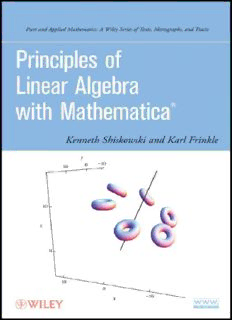Table Of ContentContents
Preface
Conventions and Notations
Chapter 1: An Introduction to Mathematica
1.1 The Very Basics
1.2 Basic Arithmetic
1.3 Lists and Matrices
1.4 Expressions versus Functions
1.5 Plotting and Animations
1.6 Solving Systems of Equations
1.7 Basic Programming
Chapter 2: Linear Systems of Equations and Matrices
2.1 Linear Systems of Equations
2.2 Augmented Matrix of a Linear System and Row Operations
2.3 Some Matrix Arithmetic
Chapter 3: Gauss—Jordan Elimination and Reduced Row
Echelon Form
3.1 Gauss-Jordan Elimination and rref
3.2 Elementary Matrices
3.3 Sensitivity of Solutions to Error in the Linear System
Chapter 4: Applications of Linear Systems and Matrices
4.1 Applications of Linear Systems to Geometry
4.2 Applications of Linear Systems to Curve Fitting
4.3 Applications of Linear Systems to Economics
4.4 Applications of Matrix Multiplication to Geometry
4.5 An Application of Matrix Multiplication to Economics
Chapter 5: Determinants, Inverses, and Cramer’s Rule
5.1 Determinants and Inverses from the Adjoint Formula
5.2 Finding Determinants by Expanding along Any Row or
Column
5.3 Determinants Found by Triangularizing Matrices
5.4 LU Factorization
5.5 Inverses from rref
5.6 Cramer’s Rule
Chapter 6: Basic Vector Algebra Topics
6.1 Vectors
6.2 Dot Product
6.3 Cross Product
6.4 Vector Projection
Chapter 7: A Few Advanced Vector Algebra Topics
7.1 Rotations in Space
7.2 “Rolling” a Circle along a Curve
7.3 The TNB Frame
Chapter 8: Independence, Basis, and Dimension for
n
Subspaces of
n
8.1 Subspaces of
n
8.2 Independent and Dependent Sets of Vectors in
n
8.3 Basis and Dimension for Subspaces of
n
8.4 Vector Projection onto a Subspace of
8.5 The Gram-Schmidt Orthonormalization Process
n m
Chapter 9: Linear Maps from to
9.1 Basics about Linear Maps
9.2 The Kernel and Image Subspaces of a Linear Map
9.3 Composites of Two Linear Maps and Inverses
9.4 Change of Bases for the Matrix Representation of a Linear
Map
Chapter 10: The Geometry of Linear and Affine Maps
10.1 The Effect of a Linear Map on Area and Arclength in Two
Dimensions
10.2 The Decomposition of Linear Maps into Rotations,
2
Reflections, and Rescalings in
10.3 The Effect of Linear Maps on Volume, Area, and Arclength
3
in
10.4 Rotations, Reflections, and Rescalings in Three Dimensions
10.5 Affine Maps
Chapter 11: Least-Squares Fits and Pseudoinverses
11.1 Pseudoinverse to a Nonsquare Matrix and Almost Solving
an Overdetermined Linear System
11.2 Fits and Pseudoinverses
11.3 Least-Squares Fits and Pseudoinverses
Chapter 12: Eigenvalues and Eigenvectors
12.1 What Are Eigenvalues and Eigenvectors, and Why Do We
Need Them
12.2 Summary of Definitions and Methods for Computing
Eigenvalues and Eigenvectors as Well as the Exponential of a
Matrix
12.3 Applications of the Diagonalizability of Square Matrices
12.4 Solving a Square First-Order Linear System of Differential
Equations
12.5 Basic Facts about Eigenvalues, Eigenvectors, and
Diagonalizability
12.6 The Geometry of the Ellipse Using Eigenvalues and
Eigenvectors
12.7 A Mathematica Eigen-Function
Bibliographic Material
Indexes
PURE AND APPLIED MATHEMATICS
A Wiley Series of Texts, Monographs, and Tracts
Founded by RICHARD COURANT
Editors Emeriti: MYRON B. ALLEN III, DAVID A. COX, PETER HILTON,
HARRY HOCHSTADT, PETER LAX, JOHN TOLAND
A complete list of the titles in this series appears at the end of this volume.
Copyright © 2011 by John Wiley & Sons, Inc. All rights reserved.
Published by John Wiley & Sons, Inc., Hoboken, New Jersey.
Published simultaneously in Canada.
No part of this publication may be reproduced, stored in a retrieval system, or
transmitted in any form or by any means, electronic, mechanical, photocopying,
recording, scanning, or otherwise, except as permitted under Section 107 or 108
of the 1976 United States Copyright Act, without either the prior written
permission of the Publisher, or authorization through payment of the appropriate
per-copy fee to the Copyright Clearance Center, Inc., 222 Rosewood Drive,
Danvers, MA 01923, (978) 750-8400, fax (978) 750-4470, or on the web at
www.copyright.com. Requests to the Publisher for permission should be
addressed to the Permissions Department, John Wiley & Sons, Inc., 111 River
Street, Hoboken, NJ 07030, (201) 748-6011, fax (201) 748-6008, or online at
http://www.wiley.com/go/permission.
Limit of Liability/Disclaimer of Warranty: While the publisher and author have
used their best efforts in preparing this book, they make no representations or
warranties with respect to the accuracy or completeness of the contents of this
book and specifically disclaim any implied warranties of merchantability or
fitness for a particular purpose. No warranty may be created or extended by sales
representatives or written sales materials. The advice and strategies contained
herein may not be suitable for your situation. You should consult with a
professional where appropriate. Neither the publisher nor author shall be liable
for any loss of profit or any other commercial damages, including but not limited
to special, incidental, consequential, or other damages.
For general information on our other products and services or for technical
support, please contact our Customer Care Department within the United States
at (800) 762-2974, outside the United States at (317) 572-3993 or fax (317) 572-
4002.
Wiley also publishes its books in a variety of electronic formats. Some content
that appears in print may not be available in electronic formats. For more
information about Wiley products, visit our web site at www.wiley.com.
Library of Congress Cataloging-in-Publication Data:
Shiskowski, Kenneth, 1954–
Principles of linear algebra with Mathematica / Kenneth Shiskowski, Karl
Frinkle.
p. cm. — (Pure and applied mathematics)
Includes index.
ISBN 978-0-470-63795-1 (hardback)
1. Algebras, Linear—Data processing. 2. Mathematica (Computer file) I.
Frinkle, Karl, 1977– II. Title.
QA185.D37S454 2011
512′.5028553—dc22
2011006420
With all textbooks, one should attempt to be consistent with notation, not only
within the text, but also within the field of mathematics on which it is based. For
the most part, we have done this.
Description:A hands-on introduction to the theoretical and computational aspects of linear algebra using Mathematica®Many topics in linear algebra are simple, yet computationally intensive, and computer algebra systems such as Mathematica® are essential not only for learning to apply the concepts to computati

